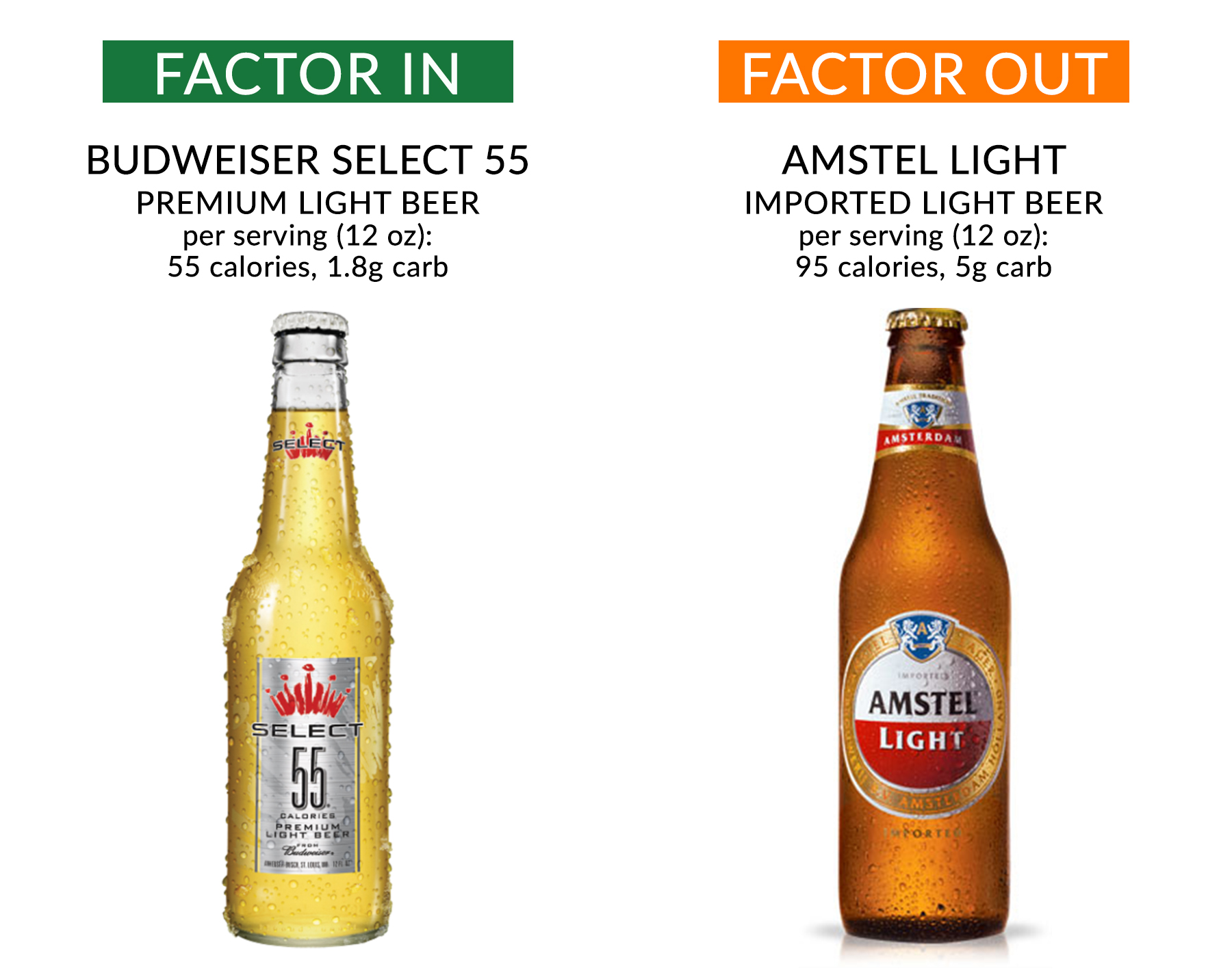FACTOR-IN/FACTOR-OUT™
We’ve scoured supermarkets and restaurants to find healthy F–Factor™ approved food swaps for high-calorie favorites. Now you can satisfy your cravings without sabotaging your waistline.*

Ice cold BEER!
Didn’t think you’d see that here, now did ya? Truth be told, we usually don’t condone beer drinking. To explain why we are today, we’ll first have to go through a very mini crash course on alcohol science (if science puts you to sleep and you just want a beer, we understand, please skip ahead to paragraph 4).
Ok, for those of you who are still with us, here we go: Beer is a fermented grain beverage. In the simplest sense, alcohol is the product of yeast fermenting carbohydrates–the carbohydrate in beer is derived from grains, and the carbohydrate in wine is derived from fruit—grapes—you knew that part, but we still haven’t gotten to the science (sleeping yet?) The carbohydrates in grains are more complex than the carbohydrates in fruit, so the yeasts that ferment the carb-base have a harder time converting grains to alcohol, in the case of making beer, than it does fruit, in the case of wine (Unrelated note: we’re happy to take a case of either, please send to the F-Factor headquarters). Either way, the process results in a fermented beverage that contains both alcohol and carbohydrates, more of the former and less of the latter with wine, because the carbs are easier to break down, and less alcohol, and more carbs with beer. If you’re a numbers person, a serving of wine is usually around 12% alcohol by volume (ABV) and contains 2g carbs, a shot of clear liquor has a much higher AVB (~40%), and 0g carbs; most regular beers have an ABV around 5% with a carb count around 12g per serving. BEER with us now, we’re almost there.
It’s the amount of carbohydrates that’s the issue (you are learning about this via F-Factor, after all). With 12 grams of carbs per serving, we’re talking slice of white bread territory here, if you know what we mean (if you don’t, pick up a copy of The F-Factor Diet Book and read chapter three). Of course, there are light beers, but in the CASE of beer, the word ‘light’ essentially means that they contain fewer calories than their un-impressive cousins. If we’re considering the carbs (which we are), we’re considering the fact that there are more in beer than there are in wine or clear spirits. Beer-buzz kill! Due to all of this, beer is traditionally not approved for Step 1 of The F-Factor Diet.
With that being said, one of the best things about F-Factor is that there are no absolute absolutes (though there is an Absolut). There are occasions during the year when beer just happens to be the appropriate beverage—concerts, sporting events, Super Bowl Sunday, the hottest July day, visiting the ol’ alma mater. For that reason, we searched high and low, far and wide for the best of the best in light beers. Ladies and Gents, even if you’re on Step 1 of the F-Factor Diet, SELECT this beer, and you’re in the clear!
We don’t know exactly how they do it, but Budweiser Select 55 actually has fewer carbohydrates than a glass of wine. We know, shocking: 1.8g carbs for an entire 12 oz bottle. And what’s better, that 55 refers to the calories—a whole bottle contains just 55 calories, which is 42% less than in an Amstel Light (and you thought all light beers were essentially the same!). With an ABV of just 2.4% too, this beverage is a select choice if you’re trying to refrain from getting too tipsy.
Cheers cheer cheers, F-Factor Friends, and as always, drink responsibly!
TO JOURNAL THIS PRODUCT: Budweiser Select 55 – 2g carbohydrate, 0g fiber
To learn more about where beer fits into F-Factor, read Living On F-Factor: Beer.